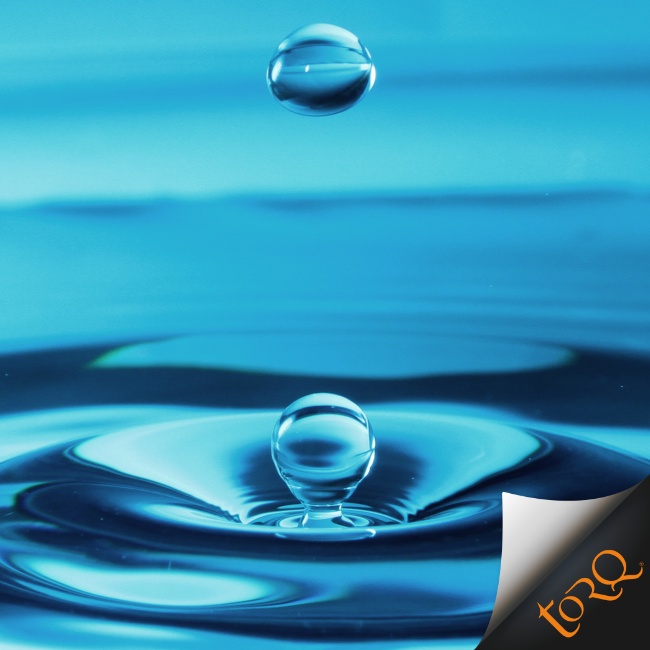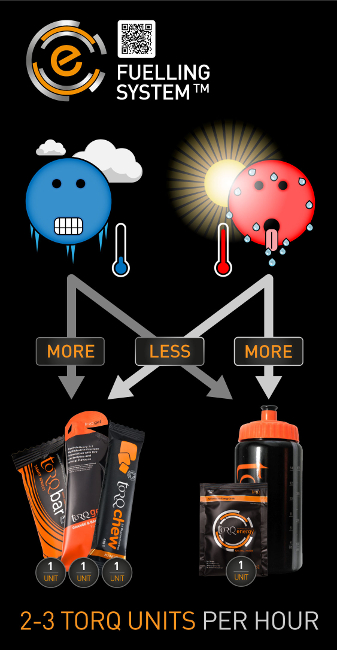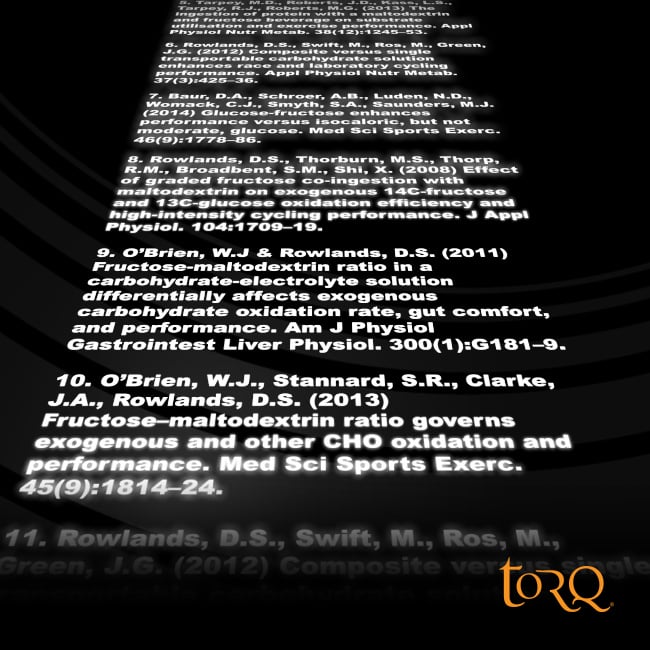Those marketing ‘Hydrogel Technology’ claim that their products relieve gastro-intestinal complaints and offer a better delivery of carbohydrate to the muscles. We review the limited scientific literature and give you our opinion.
First and foremost, if you’re new to the TORQ website and the philosophy/ethos of the brand, all we are interested in is the truth. If the research supports a tweaking of our formulations or product offering, we will do it. We’re not here to deliberately discredit other brands, we just want and need to be a trusted education-first resource for our customers or anyone else visiting our website.
What is a Hydrogel?
A hydrogel (in the context of sports nutrition) is an energy drink or gel comprised of water, carbohydrate, sodium alginate and pectin, the latter two ingredients used as the gelling agents. The marketable component to this mixture is that the hydrogel formulation is not a gel in the packet, but instead forms the hydrogel when the mixture hits the stomach acid. The acidic nature of the stomach bile results in the formation of the hydrogel which it is claimed traps carbohydrate inside a jelly-like bubble, theoretically allowing the carbohydrate to be released from the stomach quicker and reducing the potential for gastric upset. On leaving the stomach, the hydrogel travels to the intestine where the alkaline environment ‘breaks’ the hydrogel bubble and carbohydrate is absorbed into the bloodstream where it will finally reach the working muscle.

Gastric Emptying
One of the main claims of a hydrogel based energy drink or gel is that the formula has the potential to improve gastric emptying. Gastric emptying, simply put, is the rate at which food and fluids leave the stomach and arrive at the small intestine where they can be absorbed into the blood and transported to the muscle for fuel.
Sutehall and colleagues (2020) investigated the effects of a hydrogel drink on gastric emptying and found that after 30-40 minutes there was less drink left in the stomach after participants consumed the hydrogel beverage compared to a traditional carbohydrate drink. Before we get too excited, we need to consider some extremely important components of this study to understand the relevance it may or may not have for the real-world. Participants of this study arrived at the lab with an empty stomach, then participants had their stomachs washed and emptied further, using a piece of equipment known as a ‘nasogastric tube’ which is hardly the usual routine one would undergo before a Sunday morning run or bike ride!

So, what type of exercise intensity did the participants undergo during this study? Well, the participants didn’t actually do any exercise. In fact, they sat in a chair completely still for 90 minutes while the amount of fluid leaving the stomach was measured and recorded. Whilst this study did show an improvement in gastric emptying for the hydrogel, the study design unfortunately didn’t come close to replicating the real-life scenario of both exercising whilst fuelling as well as considering the recognised optimal fuelling protocol of consuming a carbohydrate-rich breakfast with a 25g serving of protein a 1-2 hours before competition/training.
Fortunately five further studies have looked at hydrogel performance whilst the participants exercised, but unfortunately none of the studies supported the use of the formulation. The studies referenced at the bottom of this article (King et al., 2020, Baur et al., 2019, Sutehall et al., 2021, Pattersson et al., 2020 & Pattersson et al., 2019) investigated the effects of hydrogels on gastric ‘comfort’ rather than ’emptying.’ Each of these studies compared a hydrogel-based drink to a drink that had the same number of calories, but in a traditional non-hydrogel solution. In these studies, participants exercised in the range of 45% & 70% of VO2 max (low – moderate intensity). The results found that whilst participants were able to tolerate a hydrogel-based drink without complications, it didn’t provide any further benefit to gastric comfort over a traditional energy drink. In fact the study from Baur et al., 2019 found that the cyclists consuming the hydrogel drink reported a slightly greater sensation of stomach fullness, which in itself could result in under-fuelling or under-hydration. Sensations of bloating would certainly discourage further drinking and there’s a strong argument to suggest that more fluid and therefore more fuel would be willingly taken on board overall via a regular energy drink compared with a hydrogel.
What these five studies had in common with the first was that in all instances, the participants started trials with an empty stomach and we have already questioned how valid this starting point is in the real world. A high carbohydrate feed and 25g of protein for breakfast is considered essential good practice for any serious sports person – the carbohydrate to replenish liver glycogen (stored carbohydrate) depleted overnight and the protein to support muscle hardware and enzyme function amongst other things. None of the research has shone any light on what happens to a hydrogel when it meets residual stomach contents?

The reason we developed the TORQ’s Fuelling System was to enable the TORQ product user to achieve optimal carbohydrate, fluid and electrolyte intake in a variety of environmental situations. When perspiration rates are higher, the user is encouraged to drink more of their calories and when they are lower, they drink less and eat more. This is a real-world solution to fuelling and hydration. A hydrogel strategy is entirely inflexible as it delivers a set amount of carbohydrate and a set amount of water. There will be times where the water and electrolytes in the hydrogel are insufficient to meet the user’s hydration needs, so what happens to the hydrogel structure when more fluid is added to it in the stomach? In the same way, what happens during cooler conditions when the user needs to consume a concentrated fuel source like an energy bar? There are then the complexities to understand regarding ultra-endurance races and multi-day events and training camps where protein would need to be consumed during exercise. How would this affect the hydrogel’s performance?

Beyond the function of a product, consideration also needs to be given to the psychology and wellbeing of the user. If there were a benefit to a hydrogel, one could imagine that the user could put up with an inflexible yet optimal strategy for short events, but over longer timeframes, this would be a big ask, even for the most hardened and disciplined of athletes. Again, the TORQ Fuelling System has been extremely carefully thought through as it provides a huge variety of flavours and textures to help keep the user motivated and happy as well as addressing their optimal nutrition and hydration requirements.
Carbohydrate Oxidation
Carbohydrate oxidation refers to the amount of carbohydrate that is burnt as a fuel. If we can deliver more carbohydrate to the working muscles via exogenous fuel (anything we eat or drink with carbohydrate in it is considered ‘exogenous’) we can afford a higher exercise intensity or increase our time to exhaustion as we preserve our limited ‘endogenous’ carbohydrate stores. The proposition made by hydrogel manufacturers is that if exogenous carbohydrate reaches the intestine more quickly (the place at which it is absorbed into the bloodstream), this should mean that more fuel can be absorbed and burnt, but this simply isn’t the case. It’s actually the intestinal carbohydrate transporters in the small intestine that are the rate-limiting factor when it comes to the absorption of carbohydrate.
The short animation below demonstrates how the intestinal transporters (SGLT-1 for glucose and GLUT5 for fructose) will become saturated at ingestion rates above 90g per hour (60g for glucose and 30g for fructose) regardless of the time taken for it to reach the intestine. Any surplus carbohydrate beyond 90g of carbohydrate per hour will then remain in the intestine and this is where gastric upset is likely to occur. Recent research has suggested that these limits could be extended with some specific Gut Training, but that really is a separate topic to the one we are discussing and would apply to any form of carbohydrate delivery, whether hydrogel or otherwise.

The 5 studies previously mentioned (King et al., 2020, Baur et al., 2019, Sutehall et al., 2021, Pattersson et al., 2020 & Pattersson et al., 2019) who found no difference in gastro-intestinal comfort also found no difference in carbohydrate oxidation between hydrogel and non-hydrogel conditions. Because oxidation rates were no different, the measures of performance were also the same between hydrogel and non-hydrogel conditions suggesting that from the limited bank of evidence currently available, hydrogels offer no benefits when compared to energy drinks and arguably have some disadvantages.
Have There Been Any Positive Findings?
Recently, a research paper from Rowe et al (2021) found that carbohydrate oxidation, performance and gastric comfort were all enhanced by consuming a hydrogel-based energy drink. These findings do come as a slight surprise as this is the first study to counter all of the negative findings to date. Even the researchers of this paper were unsure how and why they arrived at the positive findings, quoting “The reasons for the discrepancy are unclear, but it may relate to differences in exercise intensity, duration, carbohydrate type and dose, training status, exercise mode or the performance test employed.“ This degree of uncertainty doesn’t provide us with any meaningful outcomes. We are still left very much in the dark as to how a hydrogel may be applied to an individual to improve performance.
This study did employ a rather intense fuelling approach that was different to many of the other studies exploring hydrogel fuelling. In this study, participants consumed carbohydrate in an exceptionally rich, 18% concentration (equivalent to 6 scoops of TORQ Energy Drink in a 500ml of water), whilst running at a moderate exercise intensity (68% of VO2max) for 2 hours followed by a 5km running time trial. Previous studies used a 7-10% solution and the exercise protocols and intensities were easier than the one used here.

This study may suggest that if a highly concentrated (hypertonic) fuel source is delivered via a hydrogel, it offers benefits over the equivalent highly concentrated energy drink? The problem is that most energy drinks aren’t very concentrated and are isotonic in nature, for the sole reason that they provide combined fuel and fluid delivery benefits over concentrated carbohydrate forms. We discuss why this is in our article Hypotonic, Isotonic or Hypertonic? The study also used glucose to form the 2:1 glucose:fructose formulation and we would have expected different results had maltodextrin been selected. In a study by Barber et al (2020), no difference was found in carbohydrate oxidation rates between hydrogel and non-hydrogel trials when maltodextin-fructose formulations were used and the carbohydrate concentrations employed were almost as high @ 16%. Maltodextrin is a glucose polymer or ‘polysacharide’, made up of many glucose molecules joined together in a chain, whereas glucose is a single molecule called a ‘monosacharide’. TORQ’s Energy Drinks and Energy Gels use maltodextrin rather than glucose as it has a much lower osmolality than glucose and this alone is likely to have accounted for the differences found in the Rowe et al study. A lower osmolality solution has been proven to have better absorption rates. Again we discuss osmolality and tonicity in our article Hypotonic, Isotonic or Hypertonic?
Another factor that wasn’t considered in the study was what is called the ‘bolus dose’ which refers to the size/amount of energy drink consumed on each feed. Research by Mears et al (2020) has demonstrated that the size of the bolus of energy drink consumed has a direct impact on gastric emptying rate. After the initial bolus, only 100ml was consumed every 15 minutes, which wouldn’t have been large enough to deliver significant gastric emptying benefits. Could larger, less frequent doses of the non-hydrogel energy drink have produced different results?

Also, the same issues stand that have been previously discussed. How can a highly concentrated hydrogel deliver adequate hydration needs when perspiration rates are very high? Even if the concentrated formulation in the study did support enhanced fuel delivery in a specific laboratory setting, it wouldn’t support the hydration needs of anyone with any more than a modest rate of perspiration. Consistent with the other research, the study doesn’t answer the question as to what would happen should the user need to consume more fluid, what form that fluid should be in and what effect will this have on the hydrogel performance? Based on the 5 studies previously mentioned, presumably the watered-down hydrogel would lose its magical properties as it becomes diluted and reaches the carbohydrate concentrations used in those studies? What we do know is that should additional fluid not be consumed when required, the subsequent dehydration would result in reduced absorption of carbohydrate, gastric issues and ultimately if left unchecked, dehydration could cause serious harm to the body. We refer you to our article Hypotonic, Isotonic or Hypertonic once again if you would like to learn more.
Conclusions
Whilst one study does show a positive finding, many more do not. Under scrutiny, we also feel that there are too many unanswered questions surrounding the one study supporting hydrogel technology and we would need to see further studies showing positive results before we would think about going to market with such a product.
Previous hydrogel research in cycling, running and cross-country skiing has failed to demonstrate any advantages and because of this, it does beg the question, did the study from Rowe et al (2021) detect performance advantages due to a highly selective experimental design and does such a sensitive formulation have a place in real-world applications? Fuelling and hydration requirements are often dictated by event demands, environmental conditions and personal preference. We believe that the hydrogel concept is fundamentally flawed, because one size simply doesn’t fit all.
The title of a recent review paper by King et al., 2020 summarises the general scientific consensus on the hydrogel topic very fairly in our opinion. The review paper is entitled ‘Carbohydrate hydrogel products do not improve performance or gastrointestinal distress during moderate-intensity endurance exercise.’

At TORQ, we will always provide you with an extensive list of references from peer-reviewed published research papers, which support the formulation and application of our products. Every article we write is referenced in this way and every product we offer for sale is similarly supported. Scroll to the bottom of this page to review the references used to build this article and simply click on the ‘Research References’ tab on each product page.
It is after obsessive scrutiny of available research that we developed the TORQ Fuelling System and we maintain that if you are looking to comprehensively address your fuelling and hydration needs for optimal performance, there is no more effective nutritional strategy than this.
If you have any further questions about this article or any other on this website, please don’t hesitate in contacting us on 0344 332 0852 or by email on enquiries@torqfitness.co.uk
If you would like further information about TORQ’s Fuelling System products or would like to purchase, please click HERE.
References
Sutehall, S., Galloway, S.D., Bosch, A. and Pitsiladis, Y., 2020. Addition of an alginate hydrogel to a carbohydrate beverage enhances gastric emptying. Med Sci Sports Exerc, 52(8), pp.1785-92.
King, A.J., Rowe, J.T. and Burke, L.M., 2020. Carbohydrate hydrogel products do not improve performance or gastrointestinal distress during moderate-intensity endurance exercise. International journal of sport nutrition and exercise metabolism, 30(5), pp.305-314.
Baur, D.A., Toney, H.R., Saunders, M.J., Baur, K.G., Luden, N.D. and Womack, C.J., 2019. Carbohydrate hydrogel beverage provides no additional cycling performance benefit versus carbohydrate alone. European Journal of Applied Physiology, 119(11), pp.2599-2608.
Sutehall, S., Muniz-Pardos, B., Bosch, A.N., Galloway, S.D. and Pitsiladis, Y., 2021. The impact of sodium alginate hydrogel on exogenous glucose oxidation rate and gastrointestinal comfort in well-trained runners. Frontiers in Nutrition, 8.
Pettersson, S., Edin, F., Bakkman, L. and McGawley, K., 2019. Effects of supplementing with an 18% carbohydrate-hydrogel drink versus a placebo during whole-body exercise in− 5 C with elite cross-country ski athletes: a crossover study. Journal of the International Society of Sports Nutrition, 16(1), pp.1-14.
Pettersson, S., Ahnoff, M., Edin, F., Lingström, P., Simark Mattsson, C. and Andersson-Hall, U., 2020. A Hydrogel Drink With High Fructose Content Generates Higher Exogenous Carbohydrate Oxidation and a Reduced Drop in Dental Biofilm pH Compared to Two Other, Commercially Available, Carbohydrate Sports Drinks. Frontiers in nutrition, 7, p.88.
Rowe, J.T., King, R.F.G.J., King, A.J., Morrison, D.J., Preston, T., Wilson, O.J. and O’Hara, J.P., 2021. Glucose and fructose hydrogel enhances running performance, exogenous carbohydrate oxidation, and gastrointestinal tolerance. Medicine and Science in Sports and Exercise.
Mears, S., Boxer, B., Sheldon, D., Wardley, H., Tarnowski, C.A., James, L. and Hulston, C., 2020. Sports drink intake pattern affects exogenous carbohydrate oxidation during running. Medicine and Science in Sports and Exercise, 52(9), pp. 1976 – 1982.
Barber, J.F., Thomas, J., Narang, B., Hengist, A., Betts, J.A., Wallis, G.A. and Gonzalez, J.T., 2020. Pectin-alginate does not further enhance exogenous carbohydrate oxidation in running. Medicine & Science in Sports & Exercise, 52(6), pp.1376-1384.







